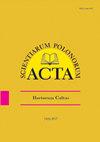Effect of orchard site and climatic conditions on plant nematode density levels
IF 0.7
4区 农林科学
Q4 HORTICULTURE
引用次数: 0
Abstract
Phytoparasitic nematodes are commonly found in the soil and their presence can lead to plant diseases, weaker growth, reduced yields and lower fruit quality. A study conducted in 2006–2009, involving the monitoring of climatic conditions, identified the influence of precipitation and temperature on the number of nematodes, in 7 sites within a cherry orchard. Soil samples to assess nematode populations were taken from 7 sites that differed in terms of cultivation and age: 5 cherry orchards established in different years. Not all nematode taxa responded in the same way to temperature increase. Members of the families Belonolaimidae, Trichodoridae and the genus Aphelenchus increased in number with rising temperatures. The negative water balance limited the number of nematodes in the soil in the layer up to 30 cm, whereas the increase in soil moisture had a positive effect on the development of Paratylenchus spp., and mebers of the family Hoplolaimidae and Heterodera. The largest total number of nematodes was found on the strip cultivated with agricultural crops after orchard liquidation. However, parasitic nematodes accounted for were at low levels (17%). The size of fruits from trees growing on sites with a large number of nematodes decreased with a simultaneous increase in total soluble solids and fruit firmness.果园地点和气候条件对植物线虫密度水平的影响
植物寄生线虫常见于土壤中,它们的存在会导致植物病害、生长疲软、产量下降和果实质量下降。2006-2009年进行的一项涉及气候条件监测的研究确定了降水和温度对樱桃园内7个地点线虫数量的影响。评估线虫种群的土壤样本取自7个栽培和年龄不同的地点:5个不同年份建立的樱桃园。并非所有线虫类群对温度升高的反应都相同。随着气温的升高,白腹蛛科、毛腹蛛科和Aphelenchus属的成员数量增加。负水平衡将土壤中线虫的数量限制在30厘米以内,而土壤湿度的增加对副热带植物的发育有积极影响。果园清理后,在与农作物一起种植的地带上发现的线虫总数最多。然而,寄生线虫所占比例较低(17%)。生长在有大量线虫的地方的树木的果实大小随着可溶性固形物总量和果实硬度的同时增加而减小。
本文章由计算机程序翻译,如有差异,请以英文原文为准。
求助全文
约1分钟内获得全文
求助全文
来源期刊
CiteScore
1.30
自引率
14.30%
发文量
61
审稿时长
4-8 weeks
期刊介绍:
In Acta Scientiarum Polonorum Hortorum Cultus we publish original research papers and review articles containing new and significant information on broad aspects of horticulture and related disciplines. The papers are published in English only, in six issues yearly.

 求助内容:
求助内容: 应助结果提醒方式:
应助结果提醒方式:


